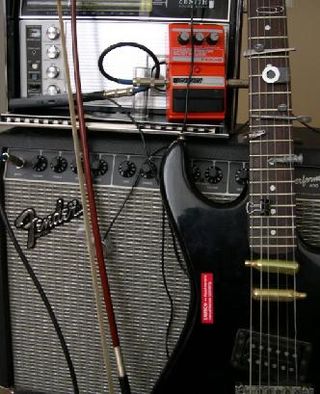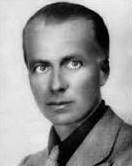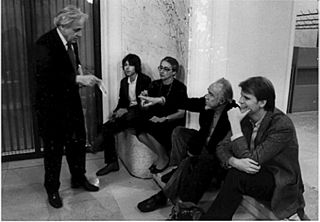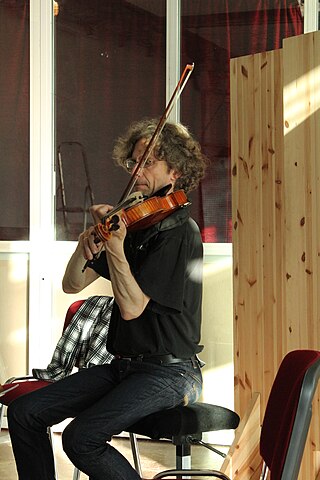Related Research Articles

The violoncello ( VY-ə-lən-CHEL-oh, Italian pronunciation:[vjolonˈtʃɛllo]), normally simply abbreviated as cello ( CHEL-oh), is a middle pitched bowed (sometimes plucked and occasionally hit) string instrument of the violin family. Its four strings are usually tuned in perfect fifths: from low to high, C2, G2, D3 and A3. The viola's four strings are each an octave higher. Music for the cello is generally written in the bass clef, tenor clef, alto clef and treble clef used for higher-range passages.

IRCAM is a French institute dedicated to the research of music and sound, especially in the fields of avant garde and electro-acoustical art music. It is situated next to, and is organisationally linked with, the Centre Pompidou in Paris. The extension of the building was designed by Renzo Piano and Richard Rogers. Much of the institute is located underground, beneath the fountain to the east of the buildings.

In music, extended technique is unconventional, unorthodox, or non-traditional methods of singing or of playing musical instruments employed to obtain unusual sounds or timbres.

Giacinto Francesco Maria Scelsi was an Italian composer who also wrote surrealist poetry in French.
David Tecchler, sometimes also written Techler, Tekler, Deckler, Dechler, Decler, Teccler or Teckler, (1666–1748) was a German luthier, best known for his cellos and double basses.
Bariolage is a musical technique used with bowed string instruments that involves rapidly playing alternated notes on adjacent strings, one of which is generally left open, thereby exploiting the different timbres of each string. Bariolage may involve quick alternation between a static note and changing notes that form a melody either above or below the static note. The static note is usually an open string note, which creates a highly resonant sound. In bluegrass fiddling the technique is known as "cross-fingering".
Zsigmond Szathmáry is a Hungarian organist, pianist, composer, and conductor.

The string section of an orchestra is composed of bowed instruments belonging to the violin family. It normally consists of first and second violins, violas, cellos, and double basses. It is the most numerous group in the standard orchestra. In discussions of the instrumentation of a musical work, the phrase "the strings" or "and strings" is used to indicate a string section as just defined. An orchestra consisting solely of a string section is called a string orchestra. Smaller string sections are sometimes used in jazz, pop, and rock music and in the pit orchestras of musical theatre.

The International Society for Contemporary Music (ISCM) is a music organization that promotes contemporary classical music.

Suzanne Giraud is a French music educator and composer of contemporary music. Her works are marked by a predilection for percussion, voices and strings; they resonate with her artistic, poetic and architectural inspirations. She has been a member of the Académie Charles Cros since January 2024.
Adriana Hölszky is a Romanian-born German music educator, composer and pianist who has been living in Germany since 1976.
Solange Ancona was a French composer.
Sargasso is a London-based record label and live events promotion company founded by Daniel Biro.

Playing the cello is done while seated with the instrument supported on the floor. The fingertips of the left hand stop the strings on the fingerboard to determine the pitch of the fingered note. The right hand plucks or bows the strings to sound the notes.
Jack Vees is an American composer and bassist from Camden, New Jersey.

Vincent Royer is a French violist and composer.
Frederic D’haene is an avant-garde composer born in Kortrijk (Belgium) in 1961. After completing musicology at Ghent University and KU Leuven, he studied composition at Royal Conservatory of Liège with Frederic Rzewski, Walter Zimmerman, Henri Pousseur and Vinko Globokar. He later worked as assistant of Frederic Rzewski at the Conservatory of Liège (1990–96). He was introduced to Gagaku Music through Tadatoshi Miyagawa and Kanehiko Togi. His own composition technique is called ‘paradoxophony’.
Petals is a piece of spectral music composed by Kaija Saariaho for cello and live electronics. It is one of the works studied in the Edexcel syllabus for the A-Level in Music. It has been recorded both by its dedicatee, Anssi Karttunen, on the Finlandia label and by the cellist Wilhelmina Smith on the Ondine label.
This page lists classical pieces in the trombone repertoire, including solo works, concertenti and chamber music of which trombone plays a significant part.
Evangeline Benedetti is an American cellist who was first woman cello player to play in the New York Philharmonic Orchestra.
References
- ↑ Dohoney, Ryan DohoneyRyan (2013), "Uitti, Frances-Marie", The Grove Dictionary of American Music, Oxford University Press, ISBN 978-0-19-531428-1
- ↑ Tom Service, "The musical and Environmental Mindfulness of John Luther Adams", The Guardian (26 February 2015)
- ↑ Stephen Brookes, "Cellist Frances-Marie Uitti Gives Virtuoso Performance in D.C. Archived 2018-04-13 at the Wayback Machine ", The Washington Post (16 February 2011)
- ↑ "Olla Podrida",
- ↑ "Frances-Marie Uitti, Cello, March 23, 2012" (PDF). REDCAT. California Institute of Arts. Retrieved 17 July 2018.
She was born in Chicago to Finnish parents, and she studied classical music at Meadowmount with Ronald Leonard and Josef Gingold, at Boston University with Leslie Parnas, and at University of Texas with George Neikrug. In Europe she worked at the Academia Chigiana with Andre Navarra, winning their top award two years in a row.
- ↑ "Frances-Marie Uitti, Cello, March 23, 2012" (PDF). REDCAT. California Institute of Arts. Retrieved 17 July 2018.
Uitti invented a radically extended technique using two bows simultaneously in one hand; she was the first to transform the cello into a 4-part chordal instrument. This technique expands the harmonic and timbral possibilities of the instrument in extraordinary ways: for example, one can play simultaneously the 4, 3, 2, and 1 string, with contrasting polyrhythmic articulations between the two bows. Non-adjacent strings can also be accessed. One bow can be played near the bridge while the other is near the fingerboard. She has used over 75 different tunings in her compositions using this technique, each producing new harmonic possibilities and exotic timbres plus a polyphony and independence of voices that her previous work with a single curved bow couldn't obtain.
- ↑ "Frances-Marie Uitti, Cello, March 23, 2012" (PDF). REDCAT. California Institute of Arts. Retrieved 17 July 2018.
Early on, she combined singing with the cello and premiered Louis Andriessen's masterpiece La Voce which is dedicated to her. Other works featuring her voice include James Tenney's concerto, "Ain't I a Woman?" with text by Sojourner Truth, David Dramm's Crosshair, Rodney Sharman's The Ecstasy of St. Teresa, Vinko Globokar's Janus, and William Kirkpatrick's Stations of the Cross.
- ↑ "Frances-Marie Uitti, Cello, March 23, 2012" (PDF). REDCAT. California Institute of Arts. Retrieved 17 July 2018.
Uitti has collaborated with and is the dedicatee of composers Luigi Nono, Louis Andriessen, James Tenney, Jonathan Harvey, John Cage, Karen Tanaka, Per Nørgård, Giacinto Scelsi, Elliott Sharp, György Kurtág, Richard Barrett, Guus Janssen, Jay Alan Yim, Vinko Globokar, Clarence Barlow, David Dramm, Geoffrey King, Martijn Padding, Horatiu Radulescu, Calliope Tsoupaki, and Peter Nelson, among many others. She collaborates in duo with Mark Dresser, and with Evan Parker, Joel Ryan, Misha Mengelberg, David Wessel, and other legends of the jazz world as well as with DJ Low, Scanner etc, and artists Stansfield/Hooykaas, Marina Abramović, Steina Vasulka, and Frank Scheffer.
- ↑ "Frances-Marie Uitti, Cello, March 23, 2012" (PDF). REDCAT. California Institute of Arts. Retrieved 17 July 2018.
While living in Rome, she worked closely with Giacinto Scelsi, not only as dedicatee of all the cello works, but also transcribing from his archive and improvising together, from 1975 until his death in 1988. Uitti premiered his newly discovered cello concerto at the Angelica Festival, Teatro Communale Bologna in 2006.
- ↑ "Frances-Marie Uitti, Cello, March 23, 2012" (PDF). REDCAT. California Institute of Arts. Retrieved 17 July 2018.
She was guest professor at Oberlin Conservatory for 2 years, and was awarded the Regents' Lectureship both at the University of California Berkeley and at University of California San Diego. She gives master classes worldwide for composers and string players at conservatories and universities including Yale, Princeton, Stanford, and University of Illinois, as well as having the Fromm Foundation Fellowship to teach during a residency at Harvard University.
- ↑ "Frances-Marie Uitti, Cello, March 23, 2012" (PDF). REDCAT. California Institute of Arts. Retrieved 17 July 2018.
In 2003, Uitti commissioned a custom-designed electric 6-string cello from Seattle luthier Eric Jensen, which she later enhanced ergonomically with sensors at CNMAT (University of California, Berkeley) working with David Wessel, Adrian Freed and Michael F. Zbyszynski. She returned to CNMAT in 2008 to design and construct a 12-stringless meta-cello with Adrian Freed. She recently acquired an aluminum cello made by the Pfretzner luthier family in 1929 (aluminum instruments were also used by Jascha Heifetz and Efram Zimbalist). She has recorded and performed on the Mongolian morin choor, a custom-built Uzbeki sato, and an original Stroh one-stringed cello.
- ↑ "Frances-Marie Uitti, Cello, March 23, 2012" (PDF). REDCAT. California Institute of Arts. Retrieved 17 July 2018.
As inventor Uitti has developed a difference-tone resonator that strongly amplifies the beating and subtle "ghost tone" produced by chordal playing. She has redesigned and built 5 prototype-bows under tutelage of bowmaker Andreas Grutter, to further facilitate her work with two bows in one hand. At the request of Scelsi, she redesigned the metallic mutes used in the String Quartet #2 and Triphon for solo cello.
- ↑ About Us, Bhutan Music Foundation
- ↑ Tuesday, January 30th 2018, FP Amsterdam evening with Frances-Marie Uitti, Féminin pluriel global (30 January 2018)
- ↑ "Frances-Marie Uitti, Cello, March 23, 2012" (PDF). REDCAT. California Institute of Arts. Retrieved 17 July 2018.
Uitti has recorded on ECM, Wergo, Hat Hut Records, CRI, BvHaast, JdKproductions, Cryptogramophone, Sargasso, and CRI.